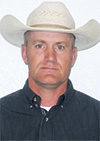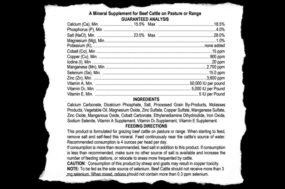Neglecting to adopt the latest high-tech device and corresponding software may render an operation less efficient and unable to thrive in the present.
One such technology has been making its move in the livestock industry, seeking to carve out its own niche in cattle management. Ultra-high-frequency (UHF) eartags have grabbed the attention of various livestock producers because of their ability to improve production efficiency.
UHF eartag technology is being embraced by many, including ranchers, feedlots and U.S.-Mexican border crossings.
Brief history
In the last decade, UHF animal identification has been rapidly advancing and making its move on radio frequency identification (RFID) technologies for livestock. The basics of RFID technology have been around since World War II.
While initial RFID technology was quite rudimentary and not too practical for most applications, it was the dawn to the era of an important RFID system.
Testing for RFIDs on livestock started during the 1970s, mostly with low-frequency (LF) transponders. The LF transponder technology was refined during the 1980s and heavily implemented in the industry around the world in the 1990s and early 2000s.
As important as these LF button tags have been, their limitations have initiated the advancement of the UHF dangle-tag technology with its many benefits.
Since 2008, many countries, such as Brazil, Canada, Korea and Australia, have either tested or have implemented UHF technology for livestock. In 2010, the USDA approved UHF tags for use in the U.S.
Why UHF?
The main advantage of UHF over LF tags is the read distance and being able to process animals at speed of commerce. UHF tags and readers allow the user to run animals through an alley multiple animals abreast versus LF or metal tags that require animals be run single-file through a chute and alley.
The UHF tags also have enhanced security. Only authorized individuals with correct pass codes can write to the tag. Anyone with a reader can access the IDs as read-only.
Ranch
UHF eartags can facilitate various cattle production management practices. Not only can they facilitate the management of cattle production record-keeping but also ease the process of collecting important data without putting them through a chute every time identification is needed for an animal. This is especially important when conducting interstate cattle movements.
In 2012, the USDA finalized the regulations surrounding interstate cattle movements to manage disease traceability. Included in those regulations is the mandate for official individual animal identification for animals moving between states.
This regulation applies to all dairy and sexually intact beef animals over 18 months old, but many states have different regulations in addition to the USDA regulations.
Without the use of UHF tags, this process can be somewhat slow and cumbersome. James Rogers, general manager of the Winecup Gamble Ranch in northeastern Nevada, has found great value with UHF tags.
With truckloads of cattle being shipped to either California or Wyoming, it’s critical to Rogers that generating interstate movement records and certificates of veterinarian inspection are done in a timely manner.
Rogers particularly favors the use of the UHF tags because there is less “hands on” the cattle since cattle IDs can be collected as groups of cattle move down an alley. There is less wear and tear to the facilities, less stress to the cattle and reduced time and labor to accomplish the task. In Rogers’ mind, these advantages provide a high return on his UHF investment.
Feedlots
In feedlots, animals are often overlooked or not discovered to be ill until they show serious clinical signs that can be noticed by a pen rider, if at all, before it is too late. If a system could be developed to monitor an animal and its drinking habits, and alert the pen rider of a significant change in pattern, anomalous animals can be pulled and treated before becoming clinical.
Let’s take these scenarios one step further. The pen rider pulls the animal with the irregular watering regimen and takes it to the hospital. Upon examination, the pen rider discovers the animal has a raised temperature and a pulmonary auscultation score, suggesting signs of bovine respiratory disease.
Since the disease was detected at such an early stage, intervening treatments are effective, and the effects to the animal’s health and weight gain are minimal with less use of expensive antibiotics.
This hypothetical scenario is not so hypothetical. Fort Supply Technologies company – a major retailer of Anitrace UHF tags and corresponding equipment and software – is currently working with four different U.S. feedlots that have installed UHF readers at water tanks.
Each time an animal comes to drink with a UHF tag in the ear, the animal’s individual identification is monitored. Each morning, the feedlot manager can view the data on his or her phone and determine whether there are any cattle requiring a closer look. If so, the feedlot manager shares the identification numbers with the pen riders, and they can go find the animals in question and tend to them as needed.
Border crossings
Full traceability of animals coming across the Mexican border is paramount to bordering U.S. states and the USDA. Unfortunately, current tags and technologies are less effective and inefficient at collecting individual animal IDs without excessive increases in personnel at border crossings.
In April of 2017, Fort Supply Technologies was contracted by the New Mexico Livestock Board, in cooperation with the USDA, to illustrate the value of UHF eartags. The pilot illustrated a UHF system is very effective at increasing the efficiency and accuracy to animal traceability on both sides of the border.
When 151 animals’ IDs in the pilot project were manually read, there were 10 visual misreads, or an error rate of 6.7 percent, and no misreads from the UHF electronic system. Each of the visual misreads were identified by the electronic system.
The visual misreads likely happened because tags were illegible, requiring cleaning and re-reading reconciling with the electronic system.
During the pilot program, it was observed personnel can be adequately trained to use the readers to collect the UHF tag data safely and in very little time. First-time users were achieving 100 percent read rates when simply scanning cattle in a 12-foot alley, off-loading from a truck or passing by them in a pen. The technology seems very promising for border crossing facilities.
Look to the future
When considering Moore’s Law, we may just be on the cusp of what UHF technology is capable of and what it will have to offer the livestock industry in the future. Could it be possible one day to scan every ID on a semi-truck loaded with cattle?
Or what if a pasture could be inventoried or cattle located with a scanner mounted on a drone? Maybe producers will be able to make notes and manage data in a remote location from their smartphone. One thing is for certain: When it comes to UHF technology, we have not yet reached the summit. ![]()
PHOTO: An operator scans UHF eartags with a hand-held reader. Photo courtesy of Fort Supply Technologies LLC.

-
Les Nunn
- Extension Educator
- University of Idaho
- Email Les Nunn







